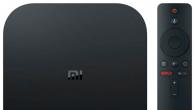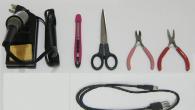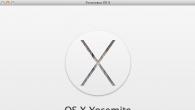I am still interested in the question of whether there have already appeared flash drives that are not inferior in speed to external hard drives. I had the opportunity to take two high-speed Sandisk flash drives with a return and test them.
For the Extreme Go flash drive, the manufacturer claims a write speed of up to 150 MB / s and a read speed of up to 200 MB / s. The packaging of the Extreme Pro flash drive lists write speeds up to 380 MB / s and read speeds up to 420 MB / s.
Both flash drives have rather large cases. Their length without a USB connector is 7 centimeters.
For both flash drives, the connectors slide into the case.
I tested the flash drives on two computers - one with an ASUS B85M-G motherboard and a Pentium G3258 Anniversary Edition processor running on Windows 7 and a computer with a Core i3-4005U processor running on Windows 10.
Both computers are equipped with USB 3.0 interfaces, but the tests showed different results.
According to the results of testing the Extreme Pro flash drive using CrystalDiskMark 3.0.4 x64, the maximum write speed was 315-340 MB / s, and the maximum read speed was 323-354 MB / s.
On the left here and below are the results on my computer, on the right - on the Acer Revo One.
The results of the usbflashspeed.com test for the same flash drive: write - 297-325 MB / s, read - 301-345 MB / s.
For unknown reasons, the write speed on different computers of the Extreme Go flash drive differed threefold: 42 MB / s on my computer and 126 MB / s on the Acer Revo One. The difference in read speed is not so significant - 152 MB / s and 185 MB / s.
A similar difference with the usbflashspeed.com test: writing - 39/143 MB / s, reading - 143/179 MB / s.
For comparison, I took another regular USB 3.0 flash drive - SanDisk Ultra Fit 64GB (I'm this type of flash drive). Write - 27/39 MB / s, read - 123/152 MB / s.
In order to test flash drives not only with the help of test programs, but also in "real life", I measured the time of writing to and reading from one large file (MP4 video 2.1 GB) and a folder with photos (1895 files, 3.7 GB).
In addition to three flash drives, the same operations were performed on an external hard drive Seagate Backup Plus Portable 2 TB USB 3.0.
The manufacturer compares the speed of the Extreme Pro flash drive with an SSD, so I measured the speed of the same operations on the disk.
Files to the tested flash drive or disk were copied from the SSD drive (when the SSD drive itself was tested, files were copied from the fastest Extreme Pro flash drive). Files from the tested flash drive or disk were copied to nul, that is, the read speed was measured in its pure form. Test results on my computer:
As you can see from the results, the Extreme Pro flash drive outperformed the external hard drive in speed and was only slightly slower than the SSD. The Extreme Go flash drive outperforms the external hard drive only in read speed.
The situation with the write speed of the Extreme Go flash drive was repeated on different computers. On my computer, the write speed of one large file is almost three times lower. Test results on Acer Revo One (the same SSD was moved from my computer to the Revo case):
So the moment has come. Flash drives that work faster than external hard drives have appeared on the market. But these flash drives are quite expensive - the tested Sandisk Extreme Pro USB 3.1 costs from 9,230 rubles, the same for 128 GB - from 5,340 rubles.
Sandisk Extreme Go USB 3.1 flash drives are significantly cheaper - the tested 64-gigabyte one costs from 2,590 rubles, the 128 GB model - from 4,270 rubles, but in terms of write speed they are slower than an external hard drive and for some reason the write speed on different computers is very different.
2017, Alexey Nadyozhin
The main topic of my blog is technology in human life. I write reviews, share experiences, talk about all sorts of interesting things. And I also make reports from interesting places and talk about interesting events.
Add me to your friend list . Remember the short addresses of my blog: Blog1.rf and Blog1rf.ru.
My second project is lamptest.ru. I test LED bulbs and help me figure out which ones are good and which are not so good.
Today our colleague in the workshop Victor Mrikh, who will tell about the agony of choosing USB flash drives in the context of possible data recovery from them.
The emergence of a "different" look at the choice of a flash drive
Very often friends and acquaintances, knowing the specifics of my work, ask me about choosing a good / reliable / stylish drive for storing data. Someone needs another flash drive, someone needs a memory card for a new gadget or camera. I usually answer that all speakers are almost equally unreliable, but as a rule, such an answer suits very few people and is perceived as an act of disrespect and indifference towards the questioner. The most stubborn continue to insist: - "This is how you choose flash drives and memory cards for yourself?" And I decided to answer ...
I choose drives from which it is possible, in the event of any trouble, to recover data with the greatest probability. The specifics of my work are as follows: absolutely new Flash disks come to our company for research, and the main task is to imitate the breakdown of this flash drive and restore the contents from it.
It recovered quickly, with the help of existing developments - well, it did not recover - it is necessary to understand and replenish the knowledge and experience base. Thus, a situation has arisen in which a list of manufacturers of flash drives and specific models of media from which data recovery, in the event of a hardware failure, occurs without any special problems, has been determined.
This is important, since it should be noted that today there are flash drives, the recovery of information from which has not been investigated not only within our company, but also since we closely communicate with all leading experts around the world and keep our finger on the pulse, we know that some devices are still unrecoverable in principle.
An idea came to my mind. Why not review the flash drives from this batch on behalf of a data recovery engineer? Perhaps this information will be useful to someone, and they will read it before the flash drive dies, burying the files that were not backed up in time.
Flash drives 64 GB. Prices
In this article, we are going to talk about seven USB Flash drives. They were all purchased from one of the chain stores on the same day.- Kingston DataTrаveler HyperX 3.0 - 4 630 rubles. (72.34 rubles per 1 GB)
- Toshiba SUZAKU - 1 840 rubles. (28.75 rubles per 1 GB)
- Kingston DataTraveler G4 - 1 920 RUB. (30 rubles for 1 GB)
- Qumo Aluminum 3.0 - 2 120 rubles. (33.13 rubles per 1 GB)
- Transcend JetFlash 780 - 3 820 rub. (59.69 rubles per 1 GB)
- Kingston DataTraveler 101 G2 - 1 840 rub. (28.75 rubles per 1 GB)
- SanDisk Extreme - 3 270 rubles. (51.09 rubles per 1 GB)
Read and write speed
For the speed test, I deliberately did not use software written by my colleagues. To test the speed of the drives, the publicly available program CrystalDiskMark version 3.0.3 was chosen. Very simple and straightforward software that shows:- Sequential read / write speed
- 512 KB random read / write speed
- 4KB Random Read / Write Speed (Queue Depth 1)
- 4KB Random Read / Write Speed (32 Queue Depth)
Kingston DataTrаveler HyperX 3.0

USB 3.0 port

USB 2.0 port

Toshiba SUZAKU

USB 3.0 port

USB 2.0 port


Kingston datatraveler g4

USB 3.0 port


USB 2.0 port


Qumo Aluminum 3.0

USB 3.0 port


USB 2.0 port


Transcend JetFlash 780

USB 3.0 port


USB 2.0 port


Kingston DataTraveler 101 G2

USB 3.0 port


Here the inattentive reader will say: "What's so little ???" The attentive reader will pay attention to the packaging from under this flash drive and will see that the USB 2.0 interface is installed on it. Most likely, this explains the lowest price in this group of flash drives.
USB 2.0 port


Sandisk extreme

USB 3.0 port


USB 2.0 port


Subtotal of tests
Leader in speed reading became a drive Transcend JetFlash 780Leader in speed records became a drive Sandisk extreme
Analysis of the results of intermediate tests
After testing the speed of reading and writing, let's calculate several important coefficients that will help determine the most profitable drive in terms of several parameters.Having calculated the ratio of read speed to the cost of 1 GB of memory

Having calculated the ratio of the write speed to the cost of 1 GB of memory, we got the following values (the higher the value, the more profitable it is to use the drive):

It will also be useful to know write speed to read speed ratio... The closer the value is to 1, the more versatile the device is, and the more “comfortable” it is to use the drive.

Logical conclusions
So, it's time to draw some basic conclusions from this pile of pictures:- If the budget is very limited and you need to find the cheapest option, the obvious choice is Toshiba SUZAKU for 1,840 rubles.
- If you need the best option, taking into account the reading speed and cost, then the choice would fall on Qumo Aluminum 3.0 for 2 120 rubles.

- Therefore, if I were shown all these tests and asked, "what would you choose for yourself personally?", I would answer that in terms of price-performance ratio, I would take Sandisk extreme.
Honesty test
Some manufacturers draw read / write speed indicators on the packaging for their drives in the hope that when choosing, the buyer will pay attention to this and make a choice in favor of this product. Let's check how the declared values differ from the real ones.Reading

Recording

It is clear that near each declared value there is a small " * ", which refers to a barely noticeable text. It says that real data may differ, testing took place in special conditions and UAV UAV UAV.
The flash drive becomes the most "honest" Transcend JetFlash 780... The missing percentages can be attributed to the measurement error. In second place - Sandisk extreme and Toshiba SUZAKU.
If something went wrong ...
Flash drives tend to break at the most inopportune moment. And it stored important data that was needed two hours ago. Frustrated, you search and find a data recovery company and go there hoping to hear the answer that everything will be ready in a few days.Further, a specialist in information recovery from flash drives begins his work. Disassembles the drive and begins to shaman and get the data piece by piece, step by step. And he thinks to himself: "Why, again, these low-quality microcircuits, again a complex controller, etc."
We tried to look at the flash drives presented in the review through the eyes of a data recovery engineer and evaluate them. And here's what happened.
Methodology and evaluation criteria
Let's try to rate the drives using a 9-point system. 4 criteria will be considered:Dismantling memory chips
- 0 points - no special problems
- 1 point - difficulties are possible
- 2 points - possible under certain conditions
- 0 points - no special problems
- 1 point - difficulties are possible
- 2 points - long-term / labor-consuming, impossible
- 0 points - no special problems
- 1 point - difficulties are possible (solvable)
- 2 points - difficulties are possible (at the moment they are unsolvable)
- 0 points - no special problems
- 1 point - difficulties are possible (solvable, laborious, long-term)
- 2 points - difficulties are possible (yet unsolvable)
Drive components
Any flash drive includes a controller (a microprocessor responsible for the distribution of user data) and memory chips (at least 1, but there may be several. It is actually on the memory chips that data are stored in a specific form). The task of an engineer for recovering data from flash drives is to emulate the operation of a controller that has failed. Let's see what our drives are made of:1.Kingston DataTrаveler HyperX 3.0
- Phison PS2251-01-L controller
- Memory chips 4 pcs in TLGA-52 package, production of Toshiba
- Toshiba TC58NC2303GST controller (re-labeled Phison PS2251-03-v)
- Memory chips 2 pcs in TSOP-48 package, production of Toshiba
- Phison PS2251-07-V controller
- Phison PS2251-07-6 controller
- Memory chips 1 pc in BGA-132 package, production of Toshiba
- Innostor IS903 Controller
- Memory chips 2 pcs in the BGA-132 case, made by Samsung
- Phison PS2251-68-5 controller
- Memory chips 1 pc in TLGA-52 package, production of Toshiba
- SanDisk Controller 20-82-08369-1
- Memory chips 1 pc in the TLGA-52 package, manufactured by SanDisk
Recovery test results
After going through all the necessary steps when recovering data from these flash drives, we got the following results:
The winner in the category of the most likely successful file recovery in the event of a breakdown was the drive Toshiba SUZAKU, since this flash drive scored the least number of points. If I were choosing a drive for myself, based on considerations of the greatest chances of successful file recovery in the event of a hardware failure, then I would have chosen it. Data recovery from it is the fastest, and the probability of getting data is very high. To be fair, it should be noted that USB drives under the Toshiba brand appeared relatively recently. This is a new player in the market, such low prices are associated with the marketing moves of the company, and, according to forecasts, prices for these products will rise.
Practical conclusions
Each of you will be able to quickly and effortlessly assess the likelihood of data recovery from your flash drive by following two simple steps:By downloading a special program from the flashboot.ru website that will help determine the composition of the drive components without disassembling it. For example, Flash Drive Information Extractor 7.5
Having learned the marking of the controller, we go to the website of the "Solution Systems" company of AceLab and search for our controller. If the controller is on the list, then your data can be restored on special equipment. If something goes wrong, and the flash drive still breaks down, then look for specialists who use the PC-3000 Flash hardware and software complex in their work. If your controller is not in the list, then the advice is to replace your USB flash drive with one from which you can recover data.
In the end, I would like to add - when choosing a drive, carefully study the prices, read the reviews and look at our Habra blog or the Hardmaster website. Perhaps this flash drive has already been in our reviews, and the test results will help us make the right choice.
That's all. And remember, Lost forever still can be found ...
Tags: Add Tags
Modern technologies are developing by leaps and bounds. Processors are getting more powerful, screens are clearer, cameras are better - all this allows you to create much more productive programs and better quality films and games than before. But this "arms race" has led to the need to store huge amounts of information. And if a 50 GB movie on your hard drive does not take up much space, then transferring it to another device is already more difficult. Fortunately, manufacturers do not forget about the good old flash drives.
There are a lot of them: MicroSD, SD, MemoryStick and a bunch of everything else. We will talk about the most familiar format for most people - USB Flash drive - or, simply speaking, about USB flash drives. In a bookish way, this is a device for storing, transferring and exchanging data (movies, music, documents, etc.). Also, flash drives are used for backing up and loading operating systems, but these areas are less popular among the population.
By their structure, most USB flash drives are quite standard: a USB interface for communication with a receiving device (computer, TV, car multimedia system, etc.), a controller, an oscillator, and directly a NAND flash memory chip. So it turns out that flash drives essentially differ little from each other, and therefore the choice of one or another model depends mainly on the speed of reading and writing, reliability and appearance. We will pay attention to these parameters in our traditional rating. Go!
Best USB 2.0 Flash Drives
First, let's take a look at the slightly older USB 2.0 flash drive technology. This standard was born back in 2000, and therefore it is difficult for it to meet modern performance standards. The maximum possible speed is 480 Mbps, which equals 60 Mb / s. It seems not so bad, but these are only theoretical figures. In fact, flash drives with USB 2.0 are capable of delivering no more than 35 meters per second when reading, and even lower for writing. Of course, there are still restrictions on the maximum current strength, but in the context of the article on flash drives, this is of little interest to us. The only thing that models from this category can boast of at the moment is the price. If we compare flash drives of similar size from the same manufacturer, it turns out that a flash drive with USB 2.0 is about 2 times cheaper than a more modern competitor.
So it turns out that it is worth recommending the models from this rating to people who either do not care much about the time spent waiting for the download, or those who work with small amounts of data, where speed is not so important. In any case, we advise you to take a look at our ranking of the best USB flash drives with a 2.0 interface.
Note! For the "purity of the experiment" in the rating, we compare the models with the most popular volume - 16 GB. Higher or lower capacity versions may differ in cost and speed.
3 Kingston DataTraveler SE9
The most stylish
Country: USA (made in China)
Average price: 710 rubles.
Rating (2018): 4.4
Unfortunately, the flash drive of one of the company's leading drives on the market does not differ in special quality. Yes, the design is interesting. The dimensions are compact. But you forget about all this when you try to upload a large file to a USB flash drive. The speed is amazing, but not in a very good way. The price, of course, is pleasant, but by winning less than 50 rubles, the buyer significantly loses in the speed of work and additional functions.
Advantages:
- Metal case
- Best price
Disadvantages:
- Slow read (22.5 MB / s) and write (15.6 MB / s) speeds
2 Transcend JetFlash 600

Best speed
Country: China
Average price: 1,120 rubles.
Rating (2018): 4.7
Transcend is engaged in the release of quite interesting drives, but it is rather difficult to call the JetFlash 600 as such. Outwardly, it does not stand out in any way - an ordinary piece of black plastic without a single hint of design sophistication. Here you can even scold the manufacturer for the lack of any fastening of the cap, which is why it is very easy to lose it. And there are no lugs on the flash drive itself, so you won't be able to attach it to the keys. The only thing that can really iron out these shortcomings is the highest speed in the rating.
Advantages:
- Best speed. Reading - up to 32 Mb / s. Recording - up to 16 Mb / s
- Password protected
- Data compression function
- Available in versions from 4GB to 128GB - the largest selection
Disadvantages:
- High cost - one and a half times higher than that of competitors
The bestmanufacturing firmsUSB- flash drives
- Sandisk. A large American corporation that has won a third of the market for memory cards and flash drives. It is the best-selling brand in this segment, including in Russia.
- Transcend. The most famous Taiwanese brand, characterized by consumers as the manufacturer of the most stable memory cards and USB sticks. Despite the modest volume of the occupied market, it is very popular among the Russian community.
- Corsair. A young American company that specializes in the production of gaming peripherals and memory modules for personal computers, as well as the creation of USB flash drives. The latter, by the way, are of average popularity among domestic consumers.
- Kingston. Founded in 1987, this company is among the leaders in the supply of USB drives, flash cards and RAM modules for personal computers to the international market. He is the owner of the world-renowned HyperX gaming memory division.
1 SanDisk Cruzer Fit

The smallest dimensions
Country: USA (made in China)
Average price: 740 rubles.
Rating (2018): 4.8
A SanDisk flash drive has almost every feature you could wish for. The main advantage over competitors is its very compact size. Yes, this is easier to lose than the overall model, but after all, people buy it mainly, judging by the reviews, for use in a car. And here the small size is just a salvation, because in many car radios, the USB connector is located in front and a large USB flash drive can simply be broken with a careless hand movement. Cruzer Fit, on the other hand, protrudes no more than 5 mm, and therefore it will be difficult to demolish it by hand. Also, this model can be recommended to owners of laptops with a small amount of internal memory. I inserted this baby into the port and forgot - there is more memory, but at the same time almost nothing sticks out.
Advantages:
- Good speed indicators. Read - 28.3 MB / s, Write - 13.96 MB / s
- The smallest dimensions
- It is possible to protect the flash drive with a password
- There is a backup function
Best USB 3.0 sticks
The USB 3.0 standard, like 2.0, can hardly be called very modern, because the final specifications were formed in 2008. Nevertheless, this interface remains popular to this day, because provides theoretical speed up to 625 Mb / s. Already impressive, huh? In fact, such flash drives give about 250 "meters" for reading, which is also a very good result. Our rating will help you choose the best model in this category.
Attention! As in the previous category, we compare models with the same volume. In this case, it is 64 GB. Other versions may differ in price and speed.
3 Transcend JetFlash 790

Best price
Country: China
Average price: 959 rubles.
Rating (2018): 4.4
As strange as it may sound, the manufacturer of the fastest flash drive in the previous category does not perform well with USB 3.0. The design is interesting, and you won't lose the lid either. Speed indicators seem to be okay too, but they are very unstable. Judging by the reviews, they differ by half! What this is connected with is not clear. Otherwise, this is a fairly standard flash drive for a small price.
Advantages:
- Data transfer indicator
- Large selection - models from 8 GB to 128 GB
Disadvantages:
- Unstable speed readings. Average 101.75 MB / s read and 44.8 MB / s write
2 Corsair Flash Voyager GS (CMFVYGS3)

Better reading speed
Country: USA (made in China)
Average price: 4 089 rubles.
Rating (2018): 4.7
Corsair products are fairly well known among computer enthusiasts and, unsurprisingly, are little known to ordinary users. And the only thing that hinders the widespread distribution of the brand is the high price. Very high. Yes, the speed of work here is one of the best in the world. Yes, the build quality and reliability are at the highest level. But, unfortunately, an ordinary customer is unlikely to want to pay 3-4 times more for a performance gain of several tens of percent.
Advantages:
- Highest speed - in real tests, read speed was 236 MB / s, writing - 170 MB / s
- Metal case
Disadvantages:
- High price
- Large dimensions
1 Kingston DataTraveler R3.0 G2

The best ratio of price and quality. Waterproof case
Country: USA (made in China)
Average price: 1,300 rubles.
Rating (2018): 4.8
Finally, we come to one of the most interesting flash drives. Its main feature is water resistance. Of course, a light rain will almost certainly survive any model, but this USB flash drive from Kingston can be safely submerged in water without fear of losing data. This can be useful not only for extremists, but also for ordinary people who are worried about the safety of important files. In addition, the speed of the flash drive does not suffer at all from the protected rubber case. On the contrary, the official figures are a little ... underestimated, which cannot but please.
Advantages:
- Waterproof housing
- Real speed is higher than officially announced - reading 141.5 MB / s, writing 44.7 MB / s
- Maximum memory capacity up to 256GB
Disadvantages:
- The case heats up noticeably under high load
The best flash drives with increased speed
The speed of writing and reading data is one of the two most important characteristics of any flash drive. It predetermines the overall speed of working with files, as well as the nominal price asked by the manufacturer (and distributors) for the purchase of USB. Not so long ago, fast flash drives had a low working resource, but at the moment this problem has been successfully resolved.
3 Corsair Flash Voyager GS (CMFVYGS3)

High degree of reliability
Country: USA
Average price: 5,290 rubles.
Rating (2018): 4.8
The Corsair Flash Voyager GS is the epitome of quality and impressive performance to satisfy the needs of any discerning user. It comes in three different memory sizes, ranging from 64 GB to 256 GB, which is a very good indicator. Accordingly, the recording speed characteristic also changes from model to model. In the "youngest" GS-ke it is only 70 Mb / s, while the "senior" has 105 Mb / s. The speed of reading files is the same in both cases - about 260 MB / s.
The USB 3.0 interface drive is clothed in a not very attractive, but reliable metal case, the degree of tightness of which reliably protects the internal circuit from dust and dirt. This design still has its drawback: the hindered heat dissipation contributes to the accumulation of heat in the flash drive circuit. In this regard, long-term work, for example, on modeling or video editing, straight from the drive can cause overheating and a concomitant failure.
2 HyperX Savage

Better stability over the entire service life
Country: USA
Average price: 6 190 rubles.
Rating (2018): 4.8
HyperX Savage is a powerful 3.1 USB flash drive designed to store colossal amounts of information. In its lineup there are as many as four models, the volume of which varies from 64 to 512 GB. Actually, this characteristic was the most impressive for thousands of users, which is clearly demonstrated by their positive reviews.
HyperX Savage's read / write performance was also a cause for great joy. As the capacity increases, the speed of data transfer changes from 180 to 250 Mb / s, which has a lot of logic behind it. At the same time, the reading speed remains the same in all versions, and does not fall below the 350 MB / s threshold. Received a portion of praise and the visual component of the drive, the lining of which is made in the traditional style of Hyper X. Actually, the totality of all the above splendor fully justifies the average price tag, slightly increased over the past year.
1 SanDisk Extreme PRO USB 3.1

User Choice
Country: USA
Average price: 6 266 rubles.
Rating (2018): 4.9
A quality USB 3.1 interface from SanDisk, designed to provide the fastest access to data storage. I found a great response among domestic users, who were greatly pleased with both the technical conditions and the overall build quality. SanDisk Extreme PRO USB 3.1 comes in two memory options: 128GB and 256GB respectively. Supports password protection of data, so you can store information of a purely personal nature on it. The data transfer / read speed on this model is also at the optimum, amounting to 380 and 420 MB / s. And, as noted by especially demanding consumers, the blitz-check of the key parameters showed their complete coincidence with the declared ones.
In favor of SanDisk Extreme PRO USB 3.1, the presence of a metal case with a connector sliding mechanism speaks. The cost, fully justified by such excellent parameters, is expectedly high, but the available margin of safety will be enough for several years to come.
The best high-capacity USB sticks
Along with read / write speed, memory capacity is a fundamental characteristic of any USB stick. It directly affects the amount of information that can be placed on the drive, and also affects the access speed according to the "more or less" principle. Such problems are often encountered on inexpensive flash drives with a volume of 16 to 128 GB, the nominal speed of which is not capable of providing users with quick access to stored data.
3 Patriot Memory Supersonic Magnum 2 512GB

Best write speed (300 MB / s)
Country: China
Average price: 17,159 rubles.
Rating (2018): 4.8
USB 3.1 flash drive, suitable for falling into several categories of this rating at once. It has, in our opinion, the most optimal memory parameter, equal to 512 GB, which is comfortably enough for both normal use and for purely working needs. It has excellent data transmission and reading rates, which are equal to 300 and 400 Mb / s, respectively. In order to make sure of the truthfulness of the declared characteristics, especially sensitive users arranged a real functional test on the flash drive ... and did not reveal any critical deviations.
However, Patriot Memory Supersonic Magnum 2 512GB still has catastrophically few consumers from among the Russian audience. The fact is that a flash drive is a very specific model, the resources of which are often not needed by a simple PC user. Hence the low popularity, and rather high price, and extremely rare appearance on store shelves.
2 PNY PRO Elite USB 3.0 512GB

Most Reliable Flash Drive (Up to 60 Months Warranty)
Country: China
Average price: 10,281 rubles.
Rating (2018): 4.8
Despite the primordial Chinese origin, PNY PRO Elite USB 3.0 512GB has one very tempting aspect of service. 60 months warranty - for important equipment (both in terms of dimensions and functions performed), this indicator is very worthy, eloquently speaking about the manufacturer's confidence in their equipment. In the case of a flash drive, it looks altogether astronomical - perhaps none of the leading manufacturers of flash drives has such a reserve of "patience".
Specifications PNY PRO Elite USB 3.0 512GB also look very impressive. Coupled with a good amount of internal memory, the consumer receives a high speed of data processing, the recording of which at the peak is at 250 MB / s, and reading at 400 MB / s. Yes, the popularity of the flash drive in Russia still leaves much to be desired. However, soon the company expects to seriously tackle the solution of this problem.
1 Kingston DataTraveler Ultimate GT 1TB

Largest internal memory (1 TB)
Country: USA
Average price: 61,200 rubles.
Rating (2018): 4.9
Kingston DataTraveler Ultimate GT is the most capacious flash drive on the Russian market at the moment. All the more interesting is the fact that it is the youngest model in the series - soon an American company is preparing to provide Russia with a copy with a memory capacity of 2 TB. However, until this happened, the terabyte version of the drive is gaining more and more popularity among professional bloggers and people whose work is somehow connected with a colossal flow of information. Its write speed indicators are at the level of elite balanced flash drives, and is 200 MB / s. The read speed, equal to 300 MB / s, also stands out positively against the general background of the characteristics.
The only real weakness in the Kingston DataTraveler Ultimate GT 1TB is the price level. It is clear that the development technology is completely new, and the finished product should recoup all the costs ... but not everyone is ready to pay the cost of a good gaming laptop for a flash drive.






